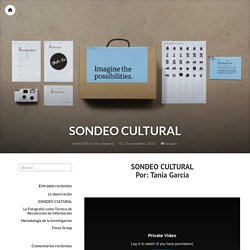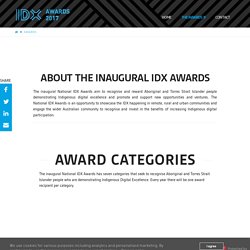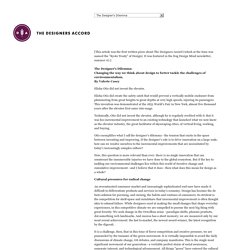

(3) Brendon Clark - “Research Through Design. A research applied toolkit for teaching design everyday” SONDEO CULTURAL – Técnicas de recolección de información. SONDEO CULTURAL Por: Tania García El sondeo cultural es un método experimental de investigación usado con el propósito de reunir información sobre un segmento de personas de una manera nueva, creativa y dinámica.

(Lyng, Webb y Nielsen, 2002) Fue proyecto de investigación financiado por la Comisión Europea para investigar las formas en que la tecnología puede ser utilizada para aumentar la presencia de las personas mayores en sus comunidades locales (Starkman y Chow, 2013, citado por Gaver, Dunne y Pacenti, 1999). Fueron las siguientes 3: Majorstua, Oslo; Bjlmer, Ámsterdam; Peccioli, Pisa. Bill Gaver, Tony Dunne y Elena Pacenti fueron los investigadores que introdujeron este nuevo método al proyecto en 1997. IDX Awards Categories. The National IDX Awards are the centrepiece of the IDX initiative, a $5 million partnership between the National Centre of Indigenous Excellence (NCIE) and Telstra Foundation, which focuses on building digital skills, entrepreneurship and opportunities for Indigenous peoples and communities.

The IDX Initiative focuses on building the digital skills of Indigenous entrepreneurs, students and communities through workshops, education and hands-on training and support. It also aims to create opportunities for improving the employment, wellbeing, health, education, cultural and environmental outcomes for all Indigenous people and their communities through the use of digital technology.
To propel IDX, NCIE and the Telstra Foundation developed ‘A Roadmap for Building Indigenous Digital Excellence: Looking to 2030’ (The Roadmap). Resume Examples 44 Resume Design Templates Example Best 10 Resume Action Verbs - Resume Samples. (11) Schooling the world. (11) Prototyping and Model Making - Students of Product Design Episode 5.
The Ekmans' Atlas of Emotions. Documento area ipg cpg 2013. Ataraxis: Therapeutic Wearbles — Dara Firoozi. Digital Driven Ideation Methods. 9 Preguntas para un proyecto. Se acerca el cuarto aniversario de Apuntateuna y esta entrada fue una de nuestras primeras y quizás la que más visitas y comentarios ha recibido, por eso creemos conveniente volver a publicarla en lugar preferente (añadiéndole enlaces a entradas publicadas posteriormente).

Gracias a toda la gente que nos sigue (cada día más). Para la imagen de cabecera hemos utilizado la ilustración titulada “El trapecista” de Beatriz Martín. ¿Quién no conoce el “modelo de las 9 preguntas” para redactar un proyecto? A priori podemos pensar que es de sobra conocido, dado que Ezequiel Ander Egg lo formuló hace ya unos años . Sin embargo, existen muchas personas que trabajan en cuestiones sociales y que no están tan familiarizadas con este modelo. Veamos a qué corresponde cada pregunta. 1. 2. 3. 4. 5. 6. 7. 8. 9.
En su momento dijimos que sobre cada pregunta volveríamos más adelante. Espero que este artículo te sea de utilidad. Hasta pronto en Apuntateuna! Slowtechnology. p816 odom DIS2012 workshop slowtech. - LOW-TECH MAGAZINE. Some Reflections on Slow Technology — I am Beck Tench. But when technology is enveloped, it is experience-oriented.

We consider things beyond what it would take to send a message, feed ourselves, or get us here from there as quickly as possible. Instead of saving every bit of time we can, we intentionally fill it with playful, reflective, or profound experiences enabled by technology. With slow technology, we can ask how the experience of using technology enhances our lives. It's not what the technology does, it’s who, how, and what we are while doing things with it. When technology is enveloped, it's like we draw a big circle around our use of it and everything in that circle becomes alive and worthy. We might value understanding how the technology works and why it does what it does.We might value how the technology inspires or requires us to reflect on it (or ourselves).We might value being thoughtful about how we apply or use the technology.
Another well known researcher of slow technology is Will Odom. Adaptive Design Assn. 16 TPD4505.leon.johannessen. The Designer's Dilemma. [This article was the first written piece about The Designers Accord (which at the time was named the "Kyoto Treaty" of Design).

It was featured in the frog Design Mind newsletter, summer 07.] The Designer's Dilemma: Changing the way we think about design to better tackle the challenges of environmentalism. By Valerie Casey Elisha Otis did not invent the elevator. Elisha Otis did create the safety catch that would prevent a vertically mobile enclosure from plummeting from great heights to great depths at very high speeds, injuring its passengers. Technically, Otis did not invent the elevator, although he is regularly credited with it. Otis exemplifies what I call the designer's dilemma - the tension that exists in the space between inventing and improving.
Now, this question is more relevant than ever: there is no single innovation that can counteract the innumerable injuries we have done to the global ecosystem. Cultural pressures for radical change We need a new strategy. Graphic Design Reading. Sebastian Deterding: Sebastian Deterding: Lo que nuestros diseños dicen de nosotros.